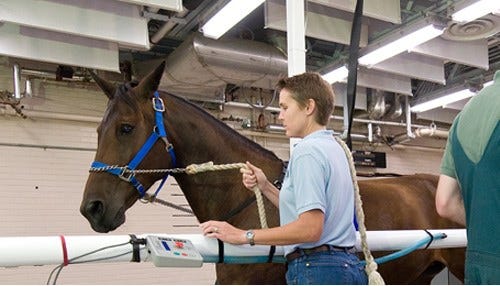Purdue to Build $35M Equine Hospital
 Reed says the equine hospital will enhance the school’s research capabilities.
Reed says the equine hospital will enhance the school’s research capabilities.
Subscriber Benefit
As a subscriber you can listen to articles at work, in the car, or while you work out. Subscribe NowPlans are underway to build a $35 million equine hospital at Purdue University’s College of Veterinary Medicine. School leaders say horses are currently crowded into the existing Large Animal Hospital where they share space with food animals, increasing the risk of disease transmission and over-extending a facility built nearly 60 years ago. Hailed as one of the top veterinary programs in the U.S., the college says the new hospital will accelerate research, update technology and benefit overall horse health.
Purdue College of Veterinary Medicine Dean Dr. Willie Reed says some of the facilities even pre-date the formation of the college in 1959, making them almost 100 years old. Reed believes the new hospital will increase the college’s success with recruitment and retention of students and staff.
“Many of the 30 veterinary schools [in the U.S.] have had significant building renovation projects in the last 10 to 15 years, and Purdue has fallen behind a little bit,” says Reed. “This will allow us to catch up.”
Physical space is also an issue; the college was built in the 1950s to accommodate about 50 students per class, but 90 are enrolled in the class now entering the four-year program. Reed notes it’s also a challenge to retro-fit aging buildings with cutting-edge technology.
“We’ll be able to expand our capabilities in the area of surgery, because we’ll have modern surgical suites,” says Reed. “We’ll also have something we’ve needed for a long time, which is an area for intensive care of very critically ill horses and foals; it will be able to offer state-of-the-art diagnostic imaging, such as MRI and CAT scan. We do some of that now, but there will be an enhanced ability to do that.”
The new 76,000 square-foot hospital will also grow the diagnostic, general treatment, sports medicine and teaching space. Reed says the facility will enhance the college’s ability diagnose lameness in horses, which is a major issue in the equine industry; it causes a horse to be unable to stand or move with a normal gait. While it’s the most common cause of loss of use in horses, its source can often be mysterious.
“Sometimes lameness requires a very extensive workup to determine the location of an injury that’s causing a horse to be lame. Many times, it requires surgery,” says Reed. “Often, it’s an orthopedic reason, and orthopedic surgery in horses is very complicated and technically difficult. You really need state-of-the-art facilities to be able to work on the horses, so you can safely put them on anesthesia and safely recover them, so they don’t further injure themselves.”
In addition to lameness, the equine hospital will enhance the school’s research in several areas critical to horse health. Purdue scientists will be able to expand their current research in bone fractures of the limbs, aiming to uncover preventative measures. The researchers are also studying the cause of upper respiratory diseases—a common issue for horses—and how to prevent and treat the illnesses.
Construction of the equine hospital is the first of three phases to overhaul Purdue’s Veterinary Teaching Hospital; the school also plans to add a second new building for small animals and a third dedicated to food animals.
The university plans to break ground on the equine hospital, which will be located just east of the current large animal hospital, a year from now.
“We’ll have a wonderful state-of-the-art facility that will allow us to provide the best quality of care to our patients and a much better environment for our students to study and learn,” says Reed. “We can look into answering some of these big research questions and just improve the overall health status of horses.”
Reed says the hospital attracts patients beyond Indiana, including pleasure horses and those from the sporting world.
Reed says multiple factors are putting pressure on the current building’s ability to accommodate a growing student body.
